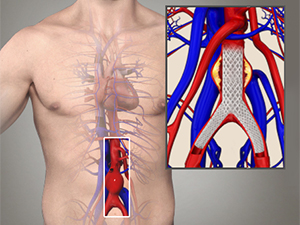Endovascular Stent Graft
 Arteries are the blood vessels that carry oxygen-rich blood from the heart to all parts of the body. An aneurysm is a balloon like bulging or swelling in a weak area along the wall of an artery. An aneurysm can grow large, eventually bursting or rupturing causing internal bleeding and possibly death. An aortic aneurysm develops in the aorta (largest blood vessel in your body) and can be treated with an endovascular (inside a blood vessel) stent graft. Endovascular stent grafting is a new treatment method for abdominal aortic aneurysms and thoracic aortic aneurysms. It is a less invasive procedure when compared to an open surgery repair. Endovascular stent grafting involves use of an endovascular stent graft to reinforce the wall of the aorta and to prevent the damaged area from rupturing.
Arteries are the blood vessels that carry oxygen-rich blood from the heart to all parts of the body. An aneurysm is a balloon like bulging or swelling in a weak area along the wall of an artery. An aneurysm can grow large, eventually bursting or rupturing causing internal bleeding and possibly death. An aortic aneurysm develops in the aorta (largest blood vessel in your body) and can be treated with an endovascular (inside a blood vessel) stent graft. Endovascular stent grafting is a new treatment method for abdominal aortic aneurysms and thoracic aortic aneurysms. It is a less invasive procedure when compared to an open surgery repair. Endovascular stent grafting involves use of an endovascular stent graft to reinforce the wall of the aorta and to prevent the damaged area from rupturing.
Indication
Your surgeon may recommend endovascular stent grafting if you are diagnosed with an abdominal aortic aneurysm or thoracic aortic aneurysm. Endovascular stent grafting is rarely used to treat aneurysms in other locations.
Pre-surgical care
Your surgeon may recommend for an MRI, CT scan or cerebral angiogram to evaluate the extent and location of the aneurysm and to decide your tolerability for surgery. Ultrasound and echocardiography can also help determine the size of the aneurysm. Angiography may be ordered to test the amount of damage or blockage of the blood vessels. In case of a ruptured aneurysm a cerebrospinal fluid sample may be tested as a pre-surgical procedure. You may also be advised to stop taking certain medication before surgery.
Surgical procedure
At the start of the procedure, you will be given regional anaesthesia or general anaesthesia depending on the need. A small incision is made in the leg near the groin. A catheter (thin tube) is inserted into an artery and advanced imaging technique is used to monitor delivery of the catheter carrying the stent graft to the area of the abdominal or thoracic aortic aneurysm. The surgeon fastens the stent graft in correct position and removes the delivery catheter. The stent graft placed inside the aorta prevents the aneurysm from bursting, allowing blood to flow freely without pushing on the weakened area of the artery.
Post-surgical care
Normally, you will have to stay in hospital for 2 to 3 days after surgery. After the first day of recovery you will be permitted to eat and walk. You will be asked to avoid driving and lifting heavy weights for almost 4 to 6 weeks or until the physician approves. You will be advised to return for a follow-up visit after the first few weeks. An imaging test may be recommended after a year to monitor the blood vessels.
Risks & complications
The complications of endovascular stent grafting include:
- Infection
- Leaking of blood around the graft
- Graft fracturing
- Movement of the graft away from the desired location
- Blockage of the blood flow through the graft







